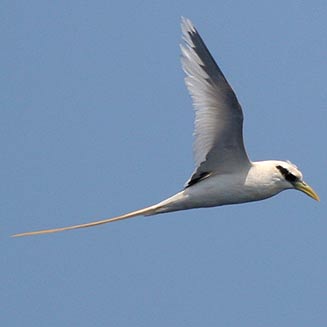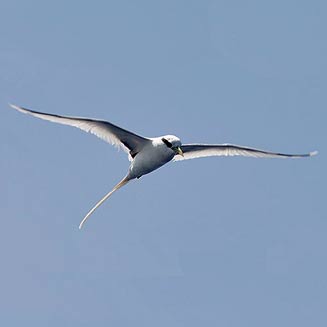|
Phaethon lepturus (White-tailed
tropicbird)
Witpylstert [Afrikaans]; Witstaartkeerkringvogel [Dutch];
Phaéton à bec jaune [French]; Weißschwanz-tropikvogel [German];
Rabijunco-de-bico-amarelo [Portuguese]
Life
> Eukaryotes >
Opisthokonta
> Metazoa (animals) >
Bilateria >
Deuterostomia > Chordata >
Craniata > Vertebrata (vertebrates) > Gnathostomata (jawed
vertebrates) > Teleostomi (teleost fish) > Osteichthyes (bony fish) > Class:
Sarcopterygii (lobe-finned
fish) > Stegocephalia (terrestrial
vertebrates) > Tetrapoda
(four-legged vertebrates) > Reptiliomorpha > Amniota >
Reptilia (reptiles) >
Romeriida > Diapsida > Archosauromorpha > Archosauria >
Dinosauria
(dinosaurs) > Saurischia > Theropoda (bipedal predatory dinosaurs) >
Coelurosauria > Maniraptora > Aves
(birds) > Order: Ciconiiformes
> Family: Phaethontidae
 |
 |
|
White-tailed tropicbird (golden-tailed morph),
Mozambique Channel. [photo
Neil Gray
©] |
White-tailed tropicbird, Mozambique Channel. [photo Trevor Hardaker ©] |
Distribution and habitat
The most globally abundant tropicbird, occurring in all
tropical and sub-tropical oceans. In southern Africa it is most common in the
Mozambique Channel, while more scarce in the area north-west of Namibia, with
isolated records along the coast of South Africa.
Food
It eats fish and squid, usually caught by plunge diving
from about 20 metres above the water, although it may hawk flying fish aerially.
Breeding
It breeds in holes and crevices on islands, especially
Ascension Island but also islands in the Gulf of Guinea and off the coast of
Brazil.
Threats
Not threatened, although colonies on remote islands are
impacted by habitat loss and the introduction of predators.
References
-
Hockey PAR, Dean WRJ and Ryan PG 2005. Roberts
- Birds of southern Africa, VIIth ed. The Trustees of the John Voelcker
Bird Book Fund, Cape Town.
|
